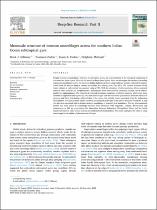| dc.description.abstract | Despite concern around plastic pollution in subtropical gyres, our understanding of the biological component of
the neustonic layer (upper 20 cm of the ocean) in these areas is poor. Here we investigate the neuston (excluding
copepods) assemblages across the Southern Indian Subtropical Gyre using triplicate samples collected by mantatrawls
from 28 stations along a transect at latitude 20 S during June/July 2015. The vertical structure of the
water column at each station was assessed using a CTD. With the exception of siphonophores, all non-copepod
neuston were identified to morphospecies. Assemblages were dominated by ostracods, mysids, larval chaetognaths
and siphonophores. The majority of collected specimens comprised facultative neuston, which were more
common at night than during the day. Neuston assemblages from the east were quite distinct from the balance of
samples, and their distribution reflected that of the warm, low salinity water associated with the Indonesian
Throughflow. Two anticyclonic eddies had been documented at the time of the survey between 70 and 85◦ E, and
this area was associated with a distinct neuston assemblage of generally low abundance. The key environmental
factors that were linked to assemblage structure were associated with longitude – salinity, fluorescence and
temperature at 200 m, emphasising the interaction between Indonesian Throughflow Water and the South
Equatorial Current, eddy-related process and settlement of meroplankton. The study highlights the value of using
morphospecies in studies of plankton assemblages. | en_US |

